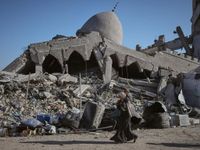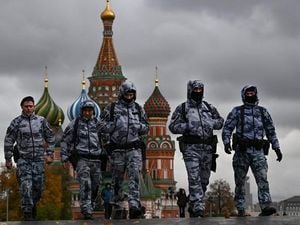Trucks, excavators, and bulldozers rumbled into Gaza on Saturday, October 25, 2025, marking a significant shift in the months-long crisis that has gripped the region since the October 2023 Hamas attack. For the first time, Israel allowed an Egyptian team to enter Gaza with specialized equipment, launching a massive operation to recover the bodies of 13 missing Israeli hostages and an estimated 10,000 Palestinians believed to be trapped under the rubble of bombed-out buildings. The move comes as international pressure mounts to uphold a fragile ceasefire and address the humanitarian catastrophe left in the wake of relentless bombardment.
According to Egypt’s Al-Qahera News, the deployment is part of a broader effort to accelerate search operations under the terms of the ceasefire agreement. The destruction in Gaza has made body retrieval extremely difficult, with collapsed buildings and unexploded ordnance complicating every step. As reported by The Times of Israel, Israeli Prime Minister Benjamin Netanyahu’s office confirmed, “It is a technical team. They are going in only to locate the slain hostages.”
Top Hamas official Khalil al-Hayya also acknowledged the new phase of cooperation, telling mediators that teams would access previously unreachable areas in Gaza to search for hostages’ remains. He added that Hamas would hand over “all administrative control of the Gaza Strip to the temporary committee, including security.” This marks a notable, if tentative, shift in the governance of the battered enclave.
The entry of heavy machinery into Gaza was not only a logistical milestone but also a political one. Israeli leaders, as reported by The Jerusalem Post, approved Egypt’s request to allow equipment and personnel entry for the recovery mission. Both Israel and Hamas reportedly provided the Egyptian team with data on the likely locations of the bodies, according to Channel 12. Israeli defense officials further told US Vice President JD Vance that Hamas could hand over the remains of at least 10 of the 13 hostages even before international recovery teams fully enter Gaza.
Of the 28 confirmed deceased hostages, 13 are still believed to be in Gaza. Hamas has so far returned 15 bodies, some of whom were killed before being taken captive, others who died in captivity. The bodies of Aryeh Zalmanovich and Tamir Adar, both hostages, were recovered earlier this year.
Saturday’s operation unfolded against the backdrop of a tense ceasefire that has largely held since October 10, 2025, but remains precarious. US President Donald Trump, en route to the ASEAN summit in Malaysia, issued a stern warning to Hamas on Truth Social: “Hamas is going to have to start returning the bodies of the deceased hostages, including two Americans, quickly, or the other countries involved in this GREAT PEACE will take action. Some of the bodies are hard to reach, but others they can return now and, for some reason, they are not. Let’s see what they do over the next 48 hours. I am watching this very closely.”
The recovery of hostages’ remains has become a central challenge of the ceasefire, which also saw the release of 20 living Israeli hostages by Hamas and the freeing of about 2,000 Palestinian detainees by Israel. According to UNI, these actions were part of the US-brokered deal, a key plank in President Trump’s Gaza peace plan. Yet, even as these exchanges took place, the Israeli military offensive has left thousands dead and the landscape of Gaza irrevocably altered.
Efforts to clear debris and rebuild critical infrastructure in Gaza have been severely hampered by Israeli restrictions on the entry of heavy machinery, a point underscored by Gaza City’s mayor, Yahya al-Sarraj. In a Sunday news conference, al-Sarraj said the city requires at least 250 heavy vehicles and 1,000 tonnes of cement to maintain water networks and construct wells. Yet, as reported by Al Jazeera, only six trucks had entered the territory by the time the recovery mission began, and the new equipment is being prioritized for recovering the remains of Israeli captives rather than assisting Palestinians in locating their loved ones.
“Palestinians say they know there won’t be any developments in the ceasefire until the bodies of all the Israeli captives are returned,” Al Jazeera’s Hind Khoudary reported from az-Zawayda in Gaza. At least 9,000 Palestinians remain buried under the rubble, their families desperate for closure and basic dignity.
Red Cross vehicles have also been allowed beyond the ceasefire’s “yellow line,” which enables Israel to retain control over 58 percent of the enclave, to assist in searching for the remains of Israeli captives. Footage circulated on social media showed Red Cross teams arriving after meetings with Hamas’s armed wing, the Qassam Brigades, to guide them to the location of a captive in southern Rafah.
Meanwhile, the threat of unexploded ordnance hangs over Gaza like a dark cloud. According to Nicholas Torbet, Middle East director at HALO Trust, Gaza is “essentially one giant city” where every part has been struck by explosives. “Some munitions are designed to linger, but what we’re concerned about in Gaza is ordnance that is expected to explode upon impact but hasn’t,” Torbet told Al Jazeera. Mahmoud Basal, spokesperson for the Palestinian Civil Defence, estimated that Israel dropped at least 200,000 tonnes of explosives on the territory, with roughly 70,000 tonnes failing to detonate. The scale of the problem is staggering: since October 2023, 328 people have been killed or injured by unexploded ordnance, according to United Nations Mine Action Service head Luke David Irving.
Children are especially vulnerable. Al Jazeera’s Ibrahim al-Khalili reported the harrowing case of seven-year-old Yahya Shorbasi and his twin sister Nabila, who mistook an unexploded device for a toy. Their mother, Latifa Shorbasi, recounted, “They found a regular children’s toy – just an ordinary one. The girl was holding it. Then the boy took it and started tapping it with a coin. Suddenly, we heard the sound of an explosion. It went off in their hands.” Yahya lost his right arm, and Nabila remains in intensive care. Dr. Harriet, an emergency doctor at al-Shifa Hospital, described the situation as “a public health catastrophe waiting to unfold.”
Reconstruction in Gaza faces further obstacles from these deadly remnants, with Basal warning that clearing the explosives could take years and require millions of dollars. The Egyptian team, in addition to recovering bodies, is also tasked with defusing unexploded ordnance left after the fighting, a critical step for any hope of rebuilding.
Politically, Israeli Prime Minister Netanyahu has moved to reassert authority at home, declaring, “We control our own security, and we have made clear to international forces that Israel will decide which forces are unacceptable to us – and that is how we act and will continue to act.” According to Al Jazeera, these statements are aimed at reassuring Netanyahu’s far-right base and maintaining political support amid the ongoing crisis.
Egypt’s intervention, meanwhile, aligns with commitments made at the Sharm el-Sheikh summit on October 13, 2025, which set out goals for a ceasefire, humanitarian aid delivery, and the exchange of captives and prisoners. Cairo also sent more than 400 trucks on Sunday carrying over 10,000 tonnes of food, fuel, and medical aid. Yet, Israel has linked the full reopening of Gaza’s crossings, including Rafah, to the return of all bodies.
For Palestinians, the situation remains a race against time. “They want reconstruction, they want freedom of movement, and they want to see and feel that the ceasefire is going to make it,” Khoudary reported. As international teams dig through the rubble and leaders negotiate the next steps, the people of Gaza wait—caught between the hope of closure and the reality of a landscape still littered with danger.
With the world watching, the recovery mission in Gaza is more than an exercise in logistics or diplomacy. It is a test of the region’s capacity for compassion, accountability, and, ultimately, peace.





